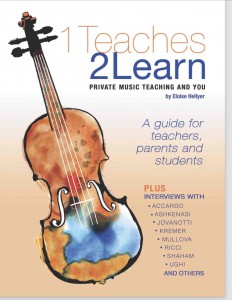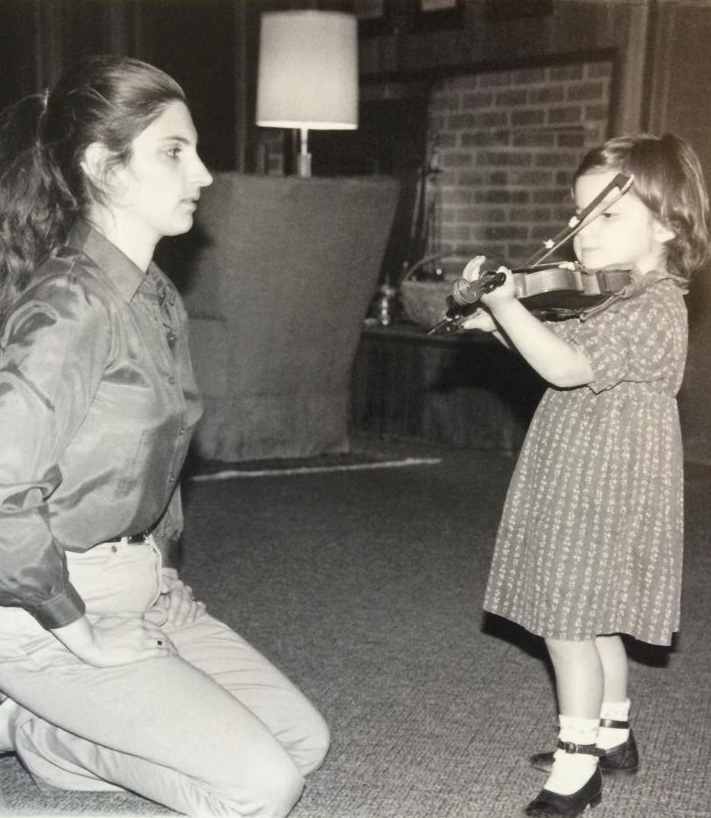The Lesson Criers
Teachers sometimes ask me how I deal with children who break into tears during the lesson. Yes, I, too, have had students who suddenly burst into tears for no apparent reason. Sooner or later, I am happy to say, they either learn to control their emotions or realize there’s no reason to cry in the first place. So how do they get to this point?
There are various situations which may provoke tears in some students. Here are a few of them with the antidotes I use.
1. Frustration: playing the violin may be the first really difficult thing these children have ever attempted. I have had many musically, physically and intellectually talented students for whom everything is easy – until they try to play the violin. The first impact of difficulty is often a shock to them, and the more emotional ones will frequently turn on the waterworks.
Antidote: The problem is not about them, but about an obstacle which surely someone as clever as themselves will surmount with a bit of determination which abounds in their character (even if it doesn’t, you still encourage this aspect). You are glad that they care so much and this is a good sign.
2. Difficulty. Learning to play the violin is just plain difficult. For everyone. I don’t know if other teachers have ever had a student to whom you show how to hold the violin, move the fingers, hold and move the bow and here’s a Paganini caprice in the first lesson, but I haven’t. Students will often cry just because it’s hard.
Antidote: Yes, it’s difficult. That’s why you need a teacher and that’s why you have to practice, which by definition means to keep trying. If it were easy, then everyone would be a great virtuoso in one lesson and I would be out of work!
3. Anger: “What? I can’t do this?!” Stomp of the foot, three or four tries, and then, tears.
Antidote: I’m so glad you’re angry! Now just use that energy and apply it to your practice and you’ll master that problem in no time! Your reaction shows you care! That’s wonderful!!
4. Astonishment: “How can this be happening to me???? I can’t do this!”
Antidote: You are surprised that this is difficult? Do you think I was born this perfect being you see before you today? (Naturally, I’m kidding.) Do you think I never had a problem? Here let me help you find a way to practice this.
5. Desperation: “Woe is me, I will never be able to do this.”
Antidote: How you’re feeling right now is how EVERY violin student feels at some point. Yes, you will be able to do this. It’s just going to take some time and persistence. Given that you are very determined (again, encouraging a quality that may not always be so evident), you will be able to conquer this. The Twinkles were difficult for you a year ago, no? Look at all you are now able to do that even a six months ago seemed impossible!
6. Gotcha: “My teacher has put her finger on the wound of some self-perceived (imagined) defect and it hurts too much to think about it.”
Antidote: You take the so-called defect and put it to a positive use or use this moment to get across something you have been trying to get them to understand for ages. This happened with a little girl just two days ago. She can play slow pieces BEAUTIFULLY (super bow control and sound), which of course is very difficult. She’s only 11 years old but can play a mean Ave Maria and has done so in church with great success. However, when she has to play fast things, she tends to get her fingers all entwined. So which comes first, the chicken or the egg? Does she have facility problems because she’s not well coordinated or because she doesn’t like to feel rushed? I decided on the second reason and said to her that I could see that she doesn’t like to feel hurried. I might have well as turned on a faucet. I didn’t acknowledge her tears but did ask her what would be the best way to make sure she doesn’t feel rushed when, for example, she has to go somewhere and has a lot of things to take with her. The answer was to prepare ahead of time. Well, I said, this also applies to violin technique and I showed her how to prepare her fingers in advance for the fast passages so she feels prepared, unhurried and relaxed. The tears dried up immediately. Of course, I had told her these things a million times before (that’s our job), but now she was able to see that she couldn’t play the fast passages well NOT because she was incapable of playing them, but because feeling hurried made her tense up and things went downhill from there. Now she understands not only what she should do but why she should do it. These teary moments can turn into break-through moments for our students if handled correctly.
7. Shame and embarrassment: “My teacher has reproved me about something and, horrors, she’s right – I’ve been caught red-handed.”
Antidote: Yes, you did (or didn’t) do that. Again, I tend to ignore the tears. NOW what are you going to do? How are we going to fix this? What is your plan? And when they reply, “Practice,” I inform them that that isn’t enough. HOW and WHAT specifically are they going to practice and how much. I try to get them to make an action plan and even if they succeed in activating only a small part of it, that’s fine because it gives me something to praise and to build on.
8. Insecurity: “If I can’t do this at first try, it means I’m no good, stupid, incapable, ugly, unlovable,” and a downward spiral from there.
Antidote: Ok, I can see you’re thinking that you are incapable of doing this. Do you really think this is true? Do you really think that a kid as intelligent and determined as you can’t do this? Are you really going to let this thing beat you?? Again, have them look at all the things they have accomplished in the last year. Tell them that they already know how to do difficult things and if they don’t believe you, then ask their mothers – or any passer by – to play the piece the child is attempting. Of course, no one but a violinist can and this always makes the student feel better. You may also want to point out, depending on the child and the circumstances that day, that immediately assuming they cannot do something gives them the excuse not even to try. You will be amazed at how illuminating this is for some children, even the youngest ones. I feel that to learn effectively they must break their bad habit of translating any difficulty they encounter in life as a direct indication of their own lack of ability.
9. “I thought i had done such a good job practicing and now my teacher is correcting me!” These students tend to see the lesson as a performance and your comments as to how they could improve as a direct criticism written in the NY Times for all to see. They ignore the positive comments you make and are offended by the corrections.
Antidote: I am here to help you improve. If you want me to be quiet or just applaud, I can do that but do you think you will learn anything? Do you want to learn something today or just be told how well you performed? Of course, they prefer the latter but will say they want the former. Slowly, slowly these children will stop crying and get on with the business of learning something at a lesson.
10. Failure: The student has played badly in public, or at least not as well as he knew he could.
Antidote: I always console my teary students when this happens (rarely, thank heavens) and I try to put things into perspective by convincing them not to dwell on their errors. I point out all the good things they did and tell them that their mistakes were not so important, that I’m glad they care so much and that we’ll talk about their little difficulties at our next lesson, but not to worry; even great musicians make mistakes, very few of us ever play up to our expectations and it’s the sign of a true artist that perfection is never achieved.
11. Some trauma in the student’s life: you say something totally innocuous to the student and a flood of tears starts. This has nothing to do with the lesson and everything to do with what is happening in the student’s life at the moment: death in the family, bullying at school, undeserved poor grades, ending of a romantic relationship, etc.
Antidote: Stop everything and get the student to talk to you. Obviously something is bothering him and you can’t have a productive lesson until he gets it off his chest. This doesn’t take much time if he wants to talk about it, and students usually do. After he has told you what is wrong and you have acknowledged it, given some small words of encouragement or condolence, you can then tell him that playing the violin will make him feel better (or at least that concentrating on something other than his troubles will) so let’s get on with the lesson.
12. Last but not least: tears of joy. Students are finally able to do something on the violin they have always wanted to but didn’t think was possible for them.
Antidote: break out the champagne!! Lots of congratulations and emphasizing how happy they should be.
So how do I deal with my criers? In a nutshell: I usually ignore the tears at first, because acknowledging them can often make it worse. Normally they are not crying because they want their tears to be noticed. in fact, they hope you don’t notice. Without making a fuss, the trick is to turn every negative thing or quality into a positive one, and perhaps even invent or magnify a few positive points, which the student can use to improve his violin practice and playing. Sometimes it’s a bit of a stretch, but if we can’t help our students understand that their so-called negative emotions and thoughts can be used positively, then we have surely failed as teachers. Crying itself is not a negative thing. It shows they care – usually about themselves, but we can take this reaction, convince them that it means they care about playing the violin well and turn it towards their learning with great positive results.
Or, as I once heard a very famous Suzuki piano teacher say matter-of-factly to a student who burst into tears during a demonstration lesson: “Don’t worry, good criers make good players!” and then she sailed right on with the lesson.*
Post Author: Eloise Hellyer
* Dr, Haruko Kataoka, or Madam Kataoka as we called her, co-inventor of the Suzuki piano method, at a British Suzuki Institute teacher training course in England circa 1981.
Share this:
Buy it on www.sharmusic.com - eBook format, avaliable worldwide, paperback in North America
COPYRIGHT
ABOUT
A music teacher’s thoughts and observations on the teaching and the study of a musical instrument, hoping to be of help to parents, students and teachers.
PHOTO
AWARDED TOP 25 VIOLIN BLOG
CATEGORIES
TAGS
ARCHIVES
-
Agosto 2022
Agosto 2023
Agosto 2024
April 2015
April 2016
April 2017
April 2019
April 2020
Aprile 2022
Aprile 2023
Aprile 2024
August 2014
August 2015
August 2016
August 2017
August 2018
August 2019
August 2021
December 2014
December 2015
December 2016
December 2017
December 2018
December 2019
December 2020
Dicembre 2022
Dicembre 2023
Dicembre 2024
Febbraio 2022
Febbraio 2023
Febbraio 2024
February 2015
February 2016
February 2018
February 2019
February 2020
February 2021
Gennaio 2022
Gennaio 2023
Gennaio 2024
Giugno 2022
Giugno 2022
Giugno 2023
Giugno 2024
January 2015
January 2016
January 2017
January 2018
January 2019
January 2020
July 2015
July 2017
July 2019
June 2016
June 2017
June 2018
June 2019
June 2020
June 2021
Luglio 2022
Luglio 2023
Luglio 2024
Maggio 2022
Maggio 2023
Maggio 2024
March 2015
March 2016
March 2017
March 2018
March 2019
March 2020
March 2021
Marzo 2022
Marzo 2023
Marzo 2024
May 2015
May 2016
May 2018
May 2019
May 2020
November 2014
November 2015
November 2016
November 2017
November 2018
November 2019
November 2021
Novembre 2022
Novembre 2023
Novembre 2024
October 2014
October 2015
October 2017
October 2018
October 2019
October 2020
October 2021
Ottobre 2022
Ottobre 2023
Ottobre 2024
September 2014
September 2015
September 2016
September 2018
September 2019
September 2020
September 2021
Settembre 2022
Settembre 2023
Settembre 2024
RECENT POSTS
Terry G and Me, or Terry Gilliam on Where (or What) Practicing the Piano Will Get You…
The Teaching We Don’t Do Is More Important Than We Think
Overwhelmingness or What Teaching and Motherhood* Have in Common
Cellphone Serenity
How to Build Your Reputation – the Kind You Want
Desperate Times, Desperate Measures. Or How to Deal With Your Strong-Willed Stubborn Student and Survive
“Why Does My Teacher Get So Frustrated?” Letter to a Perplexed Student
Mount Rush-no-more….And How to Get There
Realizzato con VelociBuilder - Another Project By: Marketing:Start! - Privacy Policy




